What is location-based marketing? Target smarter, sell more
Location-based marketing helps you reach the right people, in the right place, at the right time. Learn how it works and how to use it to boost conversions.
Reaching the right customers at the right moment can make the difference between a sale and a missed opportunity. But with so many marketing messages competing for attention, generic campaigns often get ignored.
Location-based marketing can be the hyper-specific, engaging solution you need. With this approach, you can deliver relevant offers to your target customers when they’re near your business.
The challenge? Many marketers struggle to balance personalization with privacy, especially when it comes to customer location and behavior data. You want to send relevant, targeted campaigns—but you don’t want to be intrusive or risk violating data privacy regulations.
In this guide, we’ll explore how location-based marketing works, examine proven campaign strategies, and share best practices for creating high-converting campaigns that your target audience actually wants to receive.
What is location-based marketing?
Location-based marketing is a strategy that targets audiences based on their real-time or historical geographic location. It can use multiple data sources, ranging from GPS and Wi-Fi signals to app usage patterns.
The goal? To deliver relevant messages when customers are in specific geographic areas.
Unlike traditional advertising that relies on broad demographic targeting, location-based marketing enables precision at the individual level. It uses both online and offline strategies:
- Online, it might involve showing different website content based on a visitor’s IP location. If a customer is in Boston, they may see snow boots as a top recommendation. If they’re in Orlando, they may see sneakers instead.
- Offline, it could mean sending push notifications to smartphone users who enter a specific geographic area around your business.
Say your company is exhibiting at an industry conference. A potential client enters the convention center where you’re exhibiting at a trade show. You can send them a push notification through the event app, offering a personalized product demo.

The evolution from billboards to mobile
Location-based marketing isn’t entirely new. Traditional approaches have included billboards placed strategically along highways and direct mail campaigns targeted to specific ZIP codes.
While these approaches are still in use, they often lack personalization. Instead of hoping the right people drive past a billboard, businesses can now deliver messages directly to smartphones when users are in the right place at the right time.
Modern approaches use sophisticated technologies like geofencing, beacon networks, and AI-powered predictive modeling to anticipate where customers will be—not just where they are now.
Why it matters in an era of personalization and privacy
Balancing personalization and customer privacy is increasingly important. Location-based marketing sits at the intersection.
Privacy concerns have grown significantly among consumers. In fact, data privacy and security rank as one of Americans’ biggest concerns (second only to the current cost of living).
Globally, 64% of consumers globally prefer to purchase from companies that personalize their experiences, according to a Qualtrics study. However, the study also reports that only around 18% of participants trust brands to use their location to target their experience.
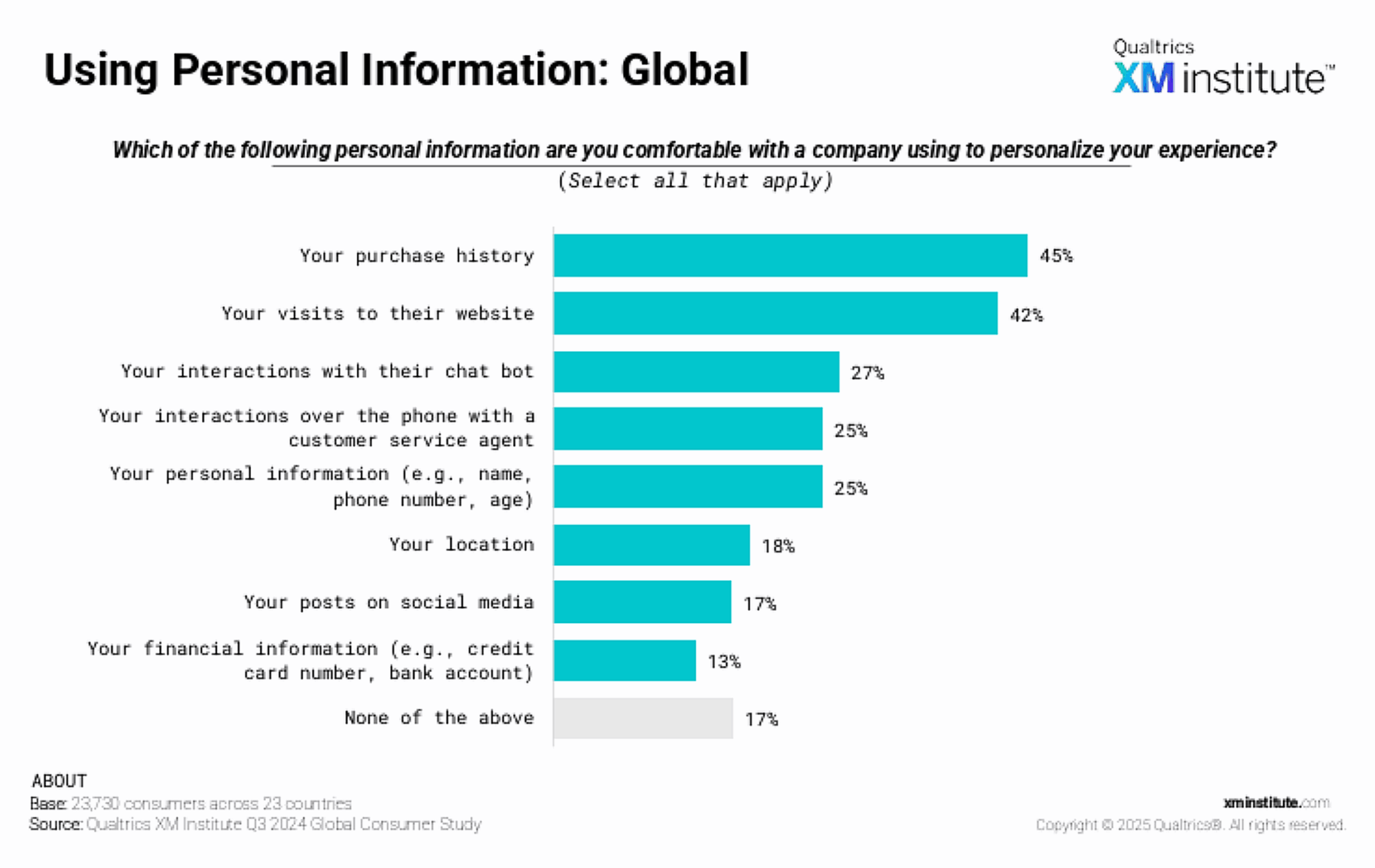
Image source: Qualtrics’ Global Research Report
Yet the need to balance personalization with privacy goes beyond consumer concerns alone.
Privacy standards like the General Data Protection Regulation (GDPR) and the California Consumer Privacy Act (CCPA) have reshaped how businesses can collect and use location data to target consumers. Companies must now provide clear value exchanges, offering meaningful benefits in return for location permissions.
Therefore, intentional, strategic, and privacy-centered location-based marketing can drive results while still maintaining customer trust.
How location-based marketing works
Location-based marketing combines real-time data with personalized delivery across channels like mobile, social, and display advertising.
It relies on multiple data sources and delivery channels working together to determine where users are and provide relevant messages at the right moment.
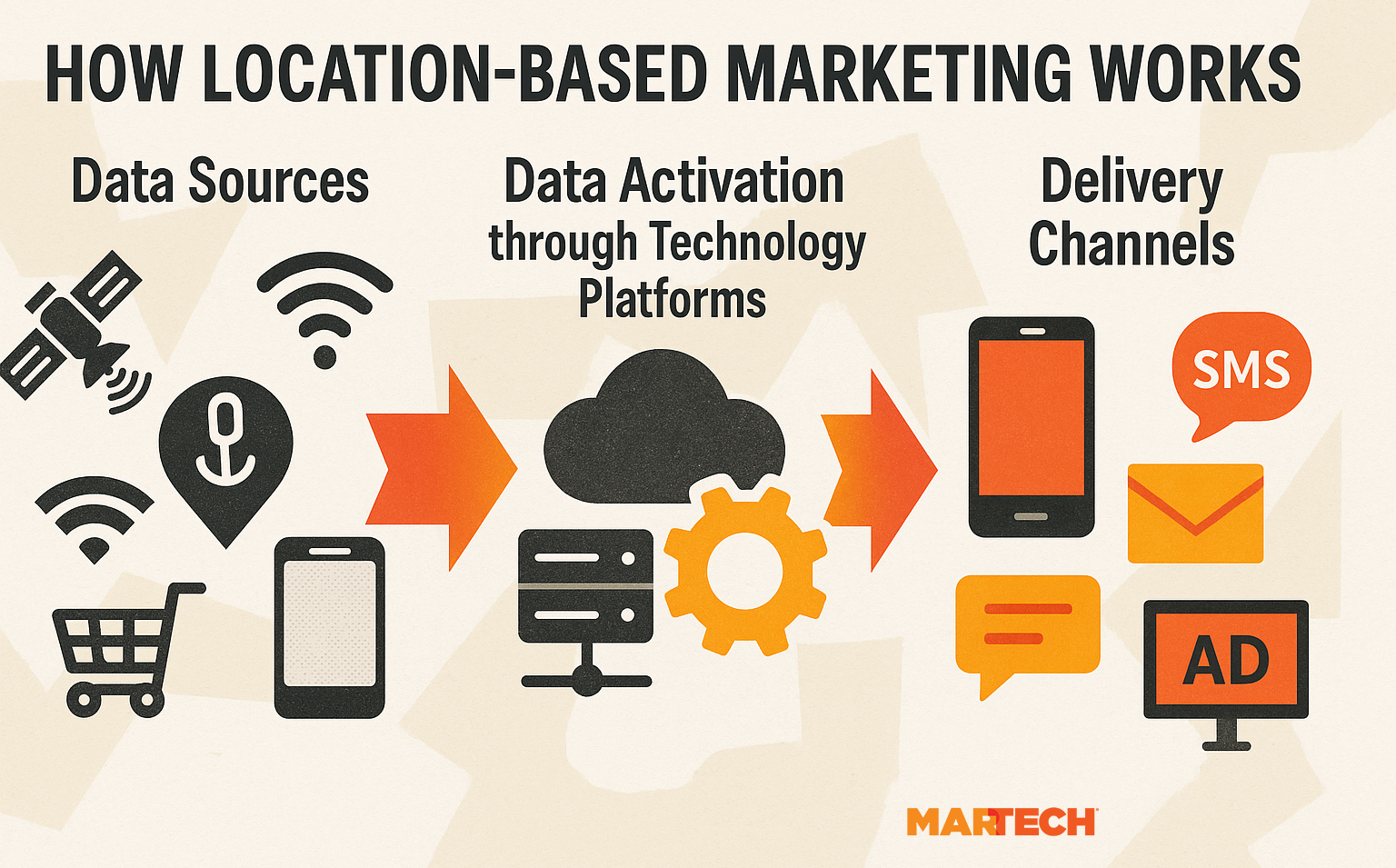
Data sources
Location-based marketing campaigns rely on many different data sources to pinpoint customers. Each source offers varying levels of accuracy and has its own unique pros and cons:
- GPS tracking: Provides precise location data, which is typically accurate within a few meters. GPS works best outdoors but can struggle indoors.
- Wi-Fi: Offers broad coverage, including indoor environments. When devices connect to Wi-Fi networks, businesses can identify users’ general locations.
- IP geolocation: Provides city or regional-level targeting. This is useful for serving targeted content to users in different markets.
- Bluetooth beacons: Enable precise indoor positioning. Small, battery-powered devices transmit Bluetooth signals to nearby smartphones. These signals allow messaging in specific store departments, corporate conference venues, or large organizations like museums.
- Cell tower triangulation: Determines your location by measuring signal strength from multiple cell towers. While less precise than GPS, it works indoors and doesn’t drain battery life as quickly as GPS tracking does.
- App and browser data: Includes first-party data like check-ins, search patterns, and behavioral signals that indicate location preferences or intentions.
Common delivery channels
Once businesses collect location data, they need effective ways to use it to reach customers. Location-based campaigns use various delivery channels, each offering distinct advantages for different types of businesses and customer interactions:
- Mobile push notifications: Offer immediate visibility and high engagement rates. They appear directly on lockscreens and notification centers, making them difficult to ignore.
- In-app advertisements: Integrate seamlessly with the user experience while providing rich creative opportunities. These ads can be highly contextual.
- SMS messaging: Provides universal reach since it doesn’t require a specific app. SMS messages can have high open rates, making them valuable for location-based promotions.
- Display advertising: Can be triggered by location data to show relevant banner ads across websites and apps. For example, someone near a shopping mall might see ads for stores within that mall.
- Social media feeds: Facebook, Instagram, and other platforms can serve location-relevant ads and content based on where users are or have been.
Say you want to increase foot traffic to your coffee shop. Many of your customers have your company’s mobile app—which uses GPS to track their location.
When they’re near one of your locations, you can automatically send a push notification, inviting them to customize their favorite drink. Since they’re already in the area, it’s a welcome reminder to swing by.

Data activation and integration
Collecting location data is just the first step. The real value comes from integrating this information with your martech stack. This lets you create comprehensive customer profiles and enable sophisticated targeting across multiple channels.
- Customer relationship management (CRM) tools: Connect location data with customer profiles. This allows personalized messaging based on purchase history, preferences, and current location.
- Data management platforms (DMPs) and customer data platforms (CDPs): Aggregate location data with other customer information. This creates comprehensive profiles that inform targeting decisions across multiple channels.
- Advertising platforms: Google Ads, Meta Ads, and programmatic advertising networks use location data to optimize ad delivery. This ensures campaigns reach users at the right time with the right messaging.
These integrations continue to become more sophisticated. Many use machine learning to identify optimal timing, messaging, and channel combinations for each individual user based on their location patterns and behavior.
Your Competitors Are Already Tracking Their AI Search Visibility—Are You?
✓ See exactly where competitors appear in ChatGPT, Perplexity, and Gemini
✓ Compare your AI search share of voice vs. top 5 competitors
✓ Identify AI visibility gaps you can capture this quarter
Built for enterprise martech stacks
Types of location-based marketing campaigns
Different campaign types serve various business objectives and customer journey stages. Understanding these approaches helps you choose the right strategy for specific goals.
| Type | What it does | Example |
| Geotargeting | Serve content or ads based on a defined region | Show different homepage offers by country |
| Geofencing | Trigger messages when a user enters a defined radius | Push a discount when someone nears your store |
| Location-aware retargeting | Serve ads based on past location visits | “Still thinking about that couch in Brooklyn?” |
| Beacon-based | Use Bluetooth in physical spaces to personalize messaging | Museums, stadiums, retail stores |
| Weather/location combos | Trigger campaigns tied to weather/local context | “Rainy day? Free delivery in NYC today.” |
Geotargeting campaigns
Geotargeting delivers different content based on users’ geographic regions. This approach works well for businesses with location-specific inventory, pricing, or regulations.
The key to successful geotargeting is relevance. Users shouldn’t feel like they’re receiving a one-size-fits-all message that’s been slightly modified for their area.
A restaurant chain might show different menu items based on regional preferences. For example, it might feature seafood prominently in coastal cities while highlighting barbecue options in Texas.
Ecommerce sites might adjust shipping options, local store information, and even currency based on visitor location. They can even run segmented PPC campaigns featuring different products or keywords depending on the user’s location.
Geofencing strategies
Geofencing creates virtual boundaries around specific locations. It triggers actions—like in-app alerts or push notifications—when users enter or exit these areas.
- Event-based geofencing targets people attending conferences, concerts, or sporting events. Businesses can offer special promotions to attendees or provide useful information like parking directions.
- Retail geofencing focuses on your own locations and surrounding areas. The goal is to attract nearby customers and increase foot traffic.
- Competitive geofencing places virtual boundaries around competitor locations. When potential customers visit competitors, they receive messages about your business.
Famously, Burger King’s “Whopper Detour” campaign involved building a 600-feet geofence around McDonald’s restaurants. When customers got close to McDonald’s, Burger King would send them a message unlocking a deal for a one-cent Whopper burger.
Location-aware retargeting
Also known as visit-based retargeting or walk-in attribution, this approach serves ads based on previous location visits.
Someone who visited a car dealership but didn’t make a purchase might see ads for specific vehicles they viewed. A person who browsed a furniture shop might see online ads that showed items they viewed in-store.
You can use retargeting even if customers don’t enter your retail location. For example, this ad below was triggered two days after the customer shopped at a grocery store next door to the Pilates studio. The user’s proximity to the studio alone meant they were a potential candidate for trial classes.
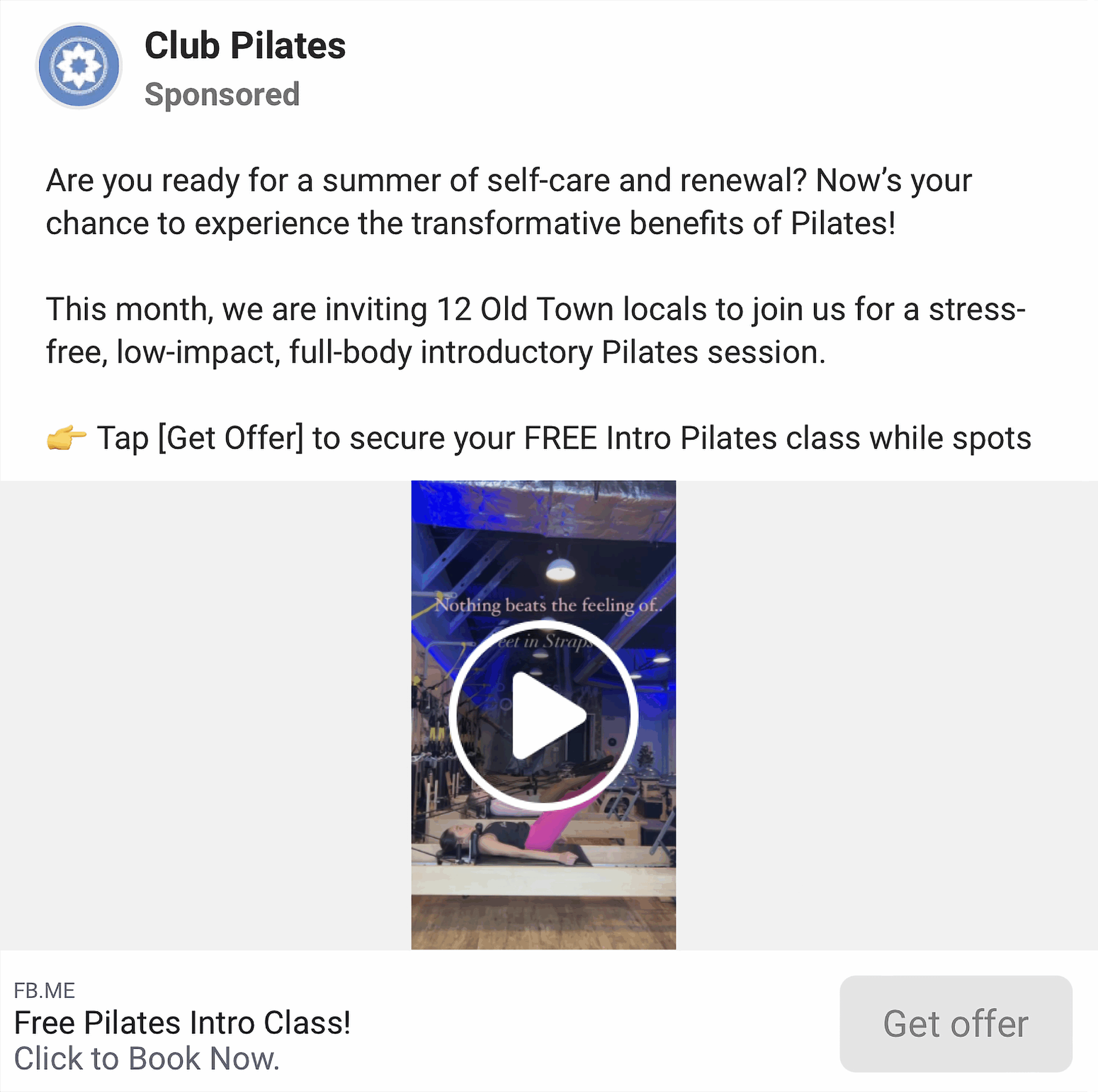
Beacon-based proximity marketing
Beacon technology enables precise location targeting in physical spaces. Major retailers use this technology to create more tailored customer experiences.
Retail beacons can guide customers to specific products, offer department-specific promotions, or provide product information when someone approaches certain items. They can show product availability, explain product locations, and boost customer loyalty programs.
Corporate environment beacons help with employee experiences, visitor management, and space optimization in office buildings.
Beacon deployments like this can operate at massive scale. Levi’s Stadium, for example, has nearly 1,700 Bluetooth beacons to help fans find the nearest restrooms, concessions, and even their seats.
Weather and context-driven campaigns
Combining location data with contextual information like weather, local events, or time of day can create opportunities for laser-focused messaging.
A coffee shop might send “warm up with our hot chocolate” messages during cold weather, while an ice cream vendor might target customers during heat waves. And sporting goods stores can promote rain gear during storms or swimwear ahead of sunny weekend forecasts come summer.
Benefits of location-based marketing
Location-based marketing lets you send the right message at the right time. Which means even enterprise companies with international reach can create relevant content for local audiences. This allows businesses to integrate into local communities, driving foot traffic and sales.
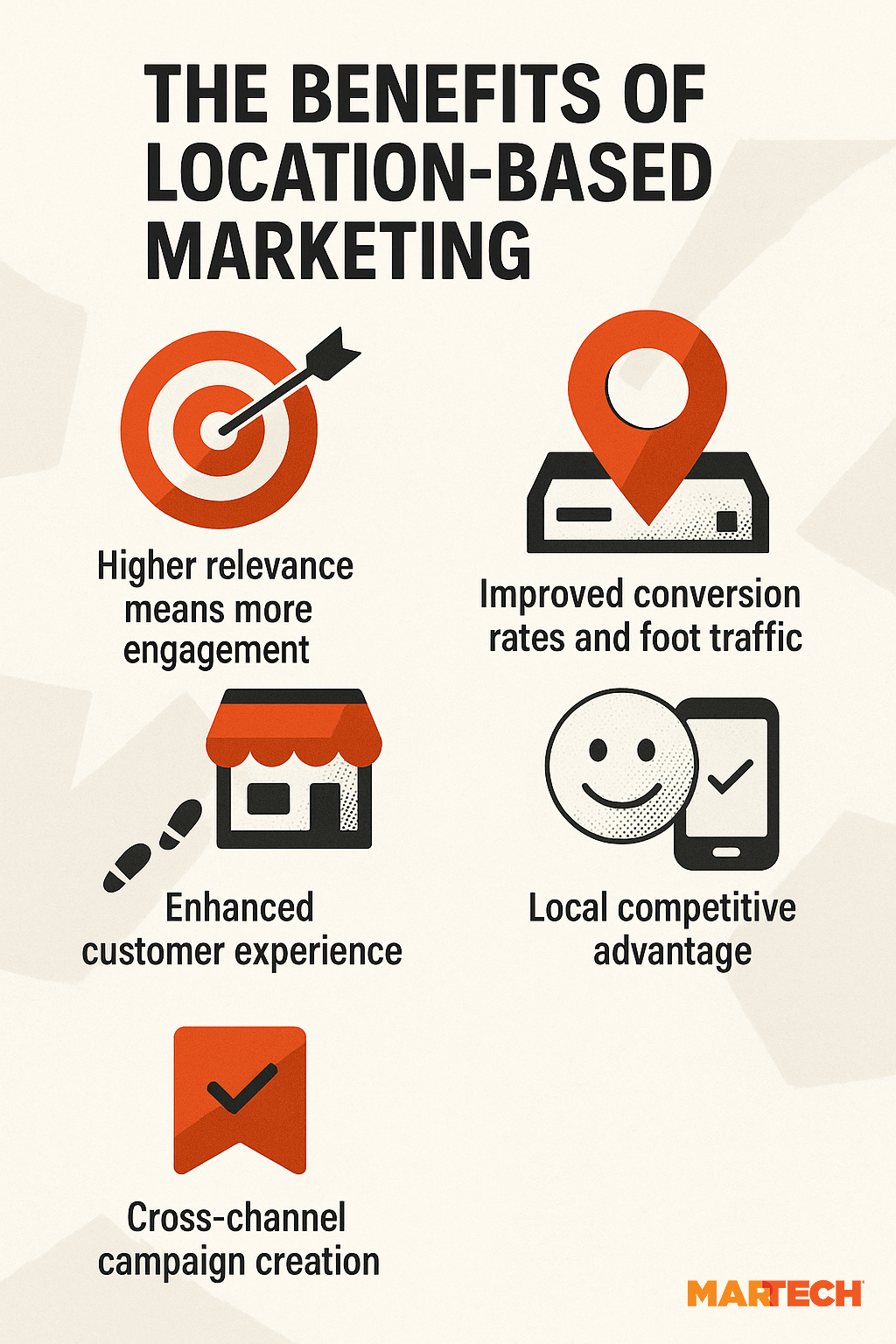
Higher relevance means more engagement
Location-based context can make messages significantly more relevant to recipients. Instead of generic promotions, customers receive offers based on their current or recent location.
This relevance can directly translate into higher engagement rates. When your messages feel timely and relevant, customers may be more likely to engage and take action.
When someone receives a discount offer while standing near your store, it feels like perfect timing rather than random advertising. This positive association can build stronger brand connections—and it allows your business to strike while the iron is hot.
Improved conversion rates and foot traffic
Proximity is on your side when it comes to location-based targeting—especially when you want to generate more foot traffic.
Customers are tempted to act immediately instead of bookmarking offers for later. This can increase conversions in the following ways:
- The option for immediate action eliminates common conversion barriers. Traditional advertising requires customers to remember offers and make separate trips. Location-based marketing presents opportunities when customers can act instantly.
- Reduced decision-making friction happens when offers arrive at optimal moments. When someone who’s already shown interest in your product or service is near your business location, a well-timed offer can help them take the next step toward a purchase.
- Competitive timing advantages emerge as your messages reach customers while they’re actively shopping or considering purchases. This may allow you to intercept competitor interactions.
Enhanced customer experience
Location-based marketing can improve rather than interrupt customer experiences when done strategically. You can create stronger, more personalized customer experiences by offering:
- Contextual assistance: Help customers navigate physical spaces more efficiently. Indoor navigation, product location guides, and service information reduce friction in the customer journey.
- Personalized service: VIP customers might receive special recognition when entering stores. Meanwhile, frequent visitors could get personalized recommendations.
- Seamless omnichannel experiences: Connect online and offline interactions. Customers can start shopping online and receive relevant information when visiting physical locations.
Dig deeper: How to prepare for the age of personalization
Competitive advantage in hyperlocal markets
Enterprise companies can stand out and dominate specific geographic areas. Location-based marketing can help your company deliver relevant content that feels local and relevant to each audience segment.
- Local market dominance becomes possible when businesses consistently engage nearby customers with relevant offers and information. Regular location-based touchpoints can build strong local brand presence even for international brands.
- Community integration opportunities arise when businesses provide location-specific value like local event information, area-specific promotions, or neighborhood-focused content.
- Agility advantages allow even large businesses to adapt a large number of location-based campaigns quickly based on local conditions, events, or competitive activities.
Cross-channel campaign orchestration
Location data enhances campaigns across marketing channels by providing additional dimensions for targeting and personalization. You can combine digital and physical campaigns into a more seamless experience.
- Email marketing becomes more relevant when location data informs content. Newsletters can include local store information, regional events, or area-specific promotions.
- Social media advertising performs better when combined with location insights. Campaigns can target users who’ve visited specific locations or show different creatives based on regional preferences.
- Content marketing can address location-specific needs, questions, or interests. Which can lead to more engaging and valuable content for different markets.
Dig deeper: Cross-channel personalization
Best practices for location-based campaigns
Successful location-based marketing requires strategic planning. You need to have clear goals, follow best practices, and pursue ongoing optimization to run effective campaigns.
Segment audiences by behavior and geography
Go beyond basic geographic boundaries and consider customer behavior patterns and preferences.
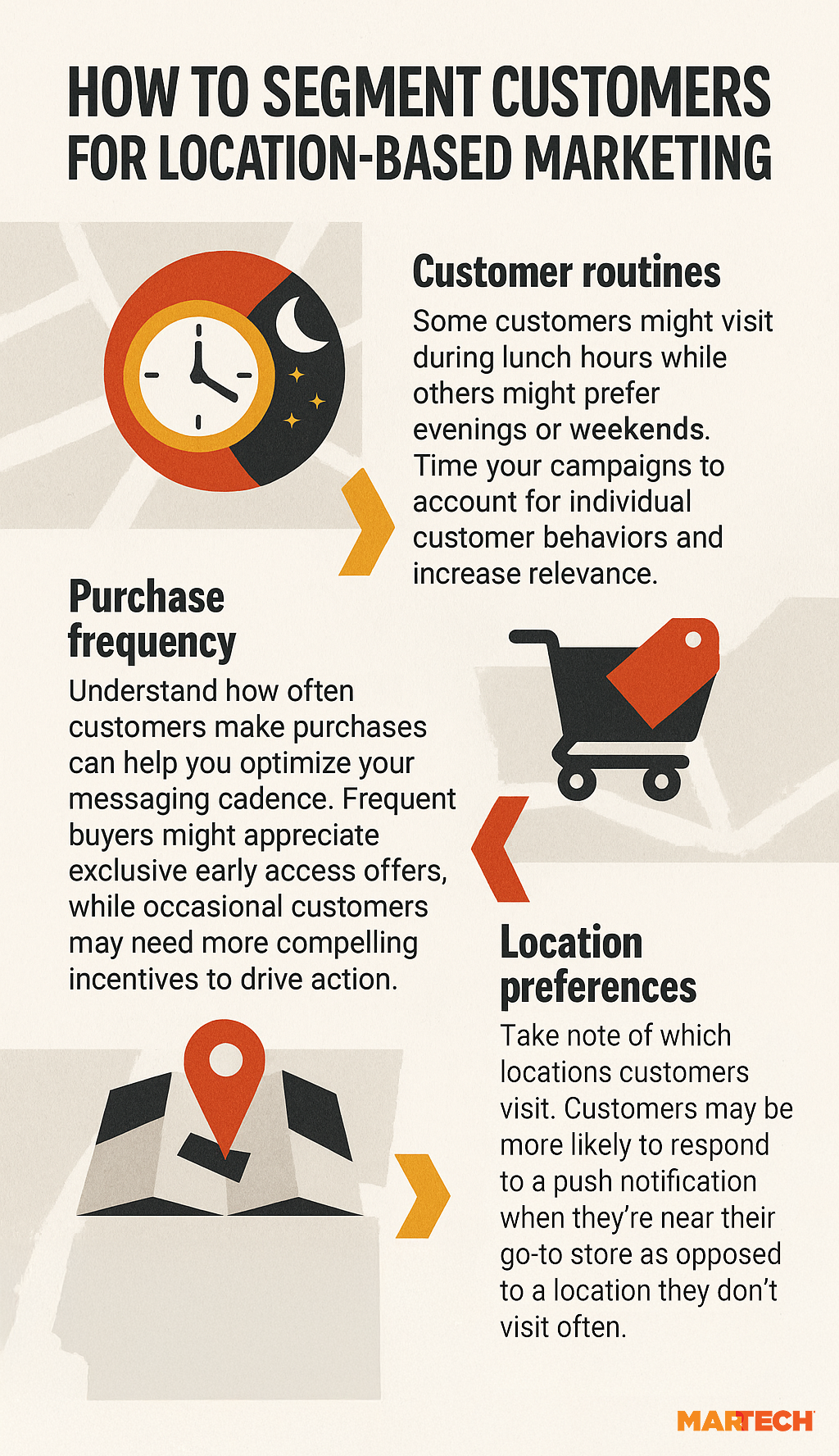
To create more relevant and personalized messaging for each customer, you can segment users by:
- Customer routines: Some customers might visit during lunch hours while others might prefer evenings or weekends. Time your campaigns to account for individual customer behaviors and increase relevance.
- Purchase frequency: Understanding how often customers make purchases can help you optimize your messaging cadence. Frequent buyers might appreciate exclusive early access offers, while occasional customers may need more compelling incentives to drive action.
- Location preferences: Take note of which locations customers visit. Customers may be more likely to respond to a push notification when they’re near their go-to store as opposed to a location they don’t visit often.
Don’t be intrusive
Campaigns should be helpful (not invasive) to increase customer engagement. After all, messaging that feels intrusive or overwhelming can cause users to disengage and unsubscribe. You can strike the right balance with these tips:
- Account for timing sensitivity. Avoid sending messages when they’d likely become an interruption. For example, avoid sending messages late at night or early in the morning when they might disturb customers.
- Manage frequency. Don’t overwhelm customers with excessive messaging. Multiple notifications during a single location visit can backfire. Daily message limits of one or two messages per day can prevent fatigue.
- Use value-first messaging. Every location-triggered communication should provide genuine value to readers. Helpful information, exclusive offers, or useful services should justify the interruption.
- Create opt-in transparency. Build trust by clearly explaining what location data is used for and providing easy ways to adjust preferences or opt out entirely. Mention this in your terms of service and when customers opt in to a particular service—like mobile app notifications.
Combine static and real-time location data
The most effective campaigns blend historical location patterns with real-time positioning to create more nuanced targeting strategies.
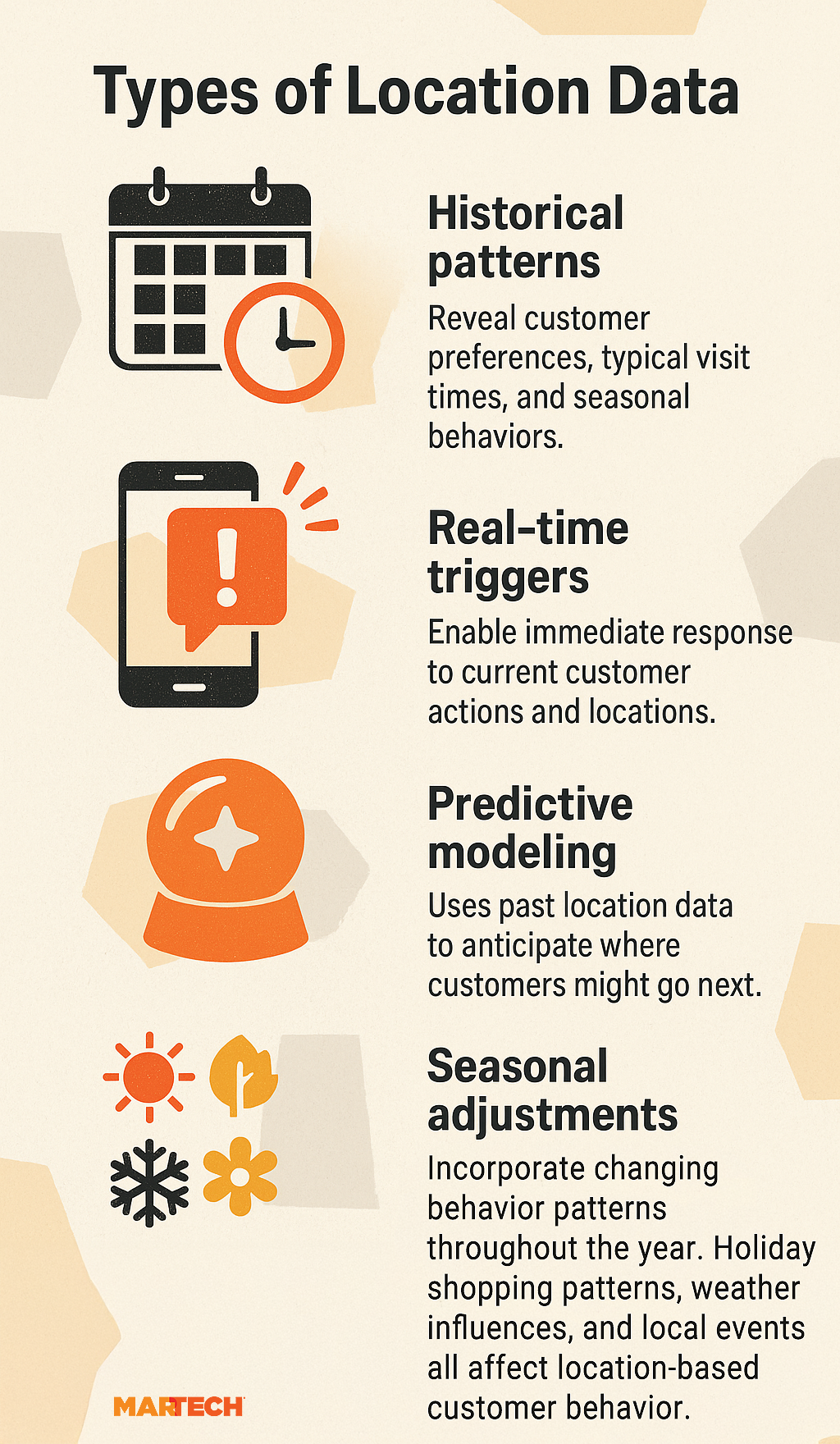
- Historical patterns reveal customer preferences, typical visit times, and seasonal behaviors. This data helps predict when customers are most likely to respond to specific types of offers.
- Real-time triggers enable immediate response to current customer actions and locations. Someone entering a geofenced area can receive instant notifications, while their historical data informs the content of those messages.
- Predictive modeling uses past location data to anticipate where customers might go next, enabling proactive rather than reactive marketing. Machine learning algorithms can identify patterns that can help you determine optimal timing and placement.
- Seasonal adjustments incorporate changing behavior patterns throughout the year. Holiday shopping patterns, weather influences, and local events all affect location-based customer behavior.
A/B test messaging by region
Location-based campaigns benefit from continuous testing and optimization. Experiment with:
- Regional message variations: Test different headlines, offers, and calls to action across different geographic markets to identify what resonates best in each area
- Timing optimization: Experiment with different send times, days of the week, and seasonal patterns to maximize engagement rates for specific locations
- Channel performance: Compare push notifications, SMS, email, and other delivery methods to determine optimal channels for different locations and customer segments
- Creative formats: Evaluate different lengths, formats, and image or text-only messages to see what resonates with each audience
A/B testing involves testing a single variable at a time. This allows for more accurate testing.
Suppose you test two or more subject lines on your audience. The data can show you which subject line actually drove clicks. But if you test the subject line, the audience, and the sender name, you won’t know which factor actually impacted results.
Tie campaigns to business goals and KPIs
Marketing campaigns are most effective when you create them with specific business objectives in mind. You may want to increase sales by boosting foot traffic, for example. Or, you might want to attract customers using competitive geofencing.
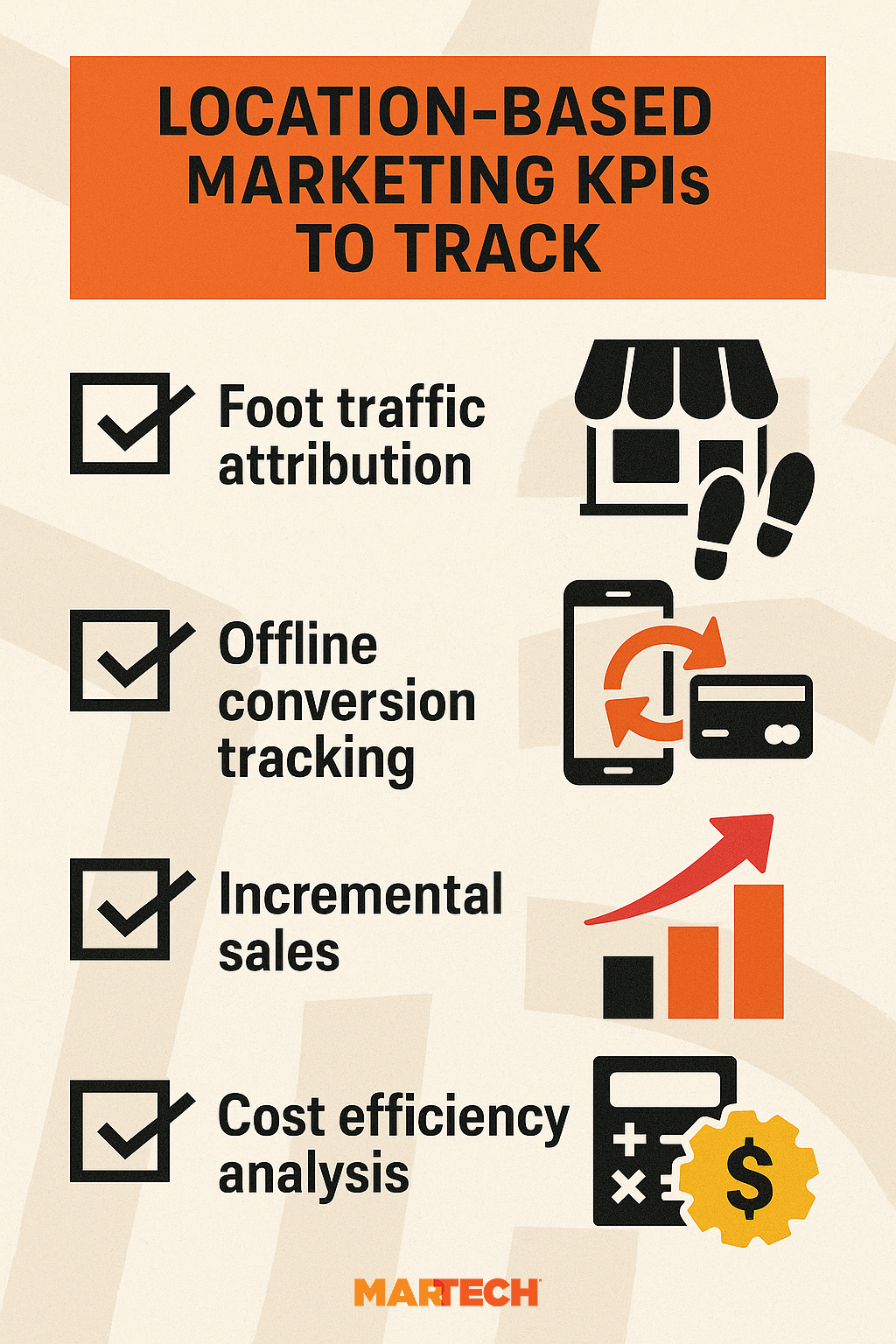
However, one of the biggest challenges with location-based marketing is proving its impact on business results. Unlike digital campaigns with clear click and conversion tracking, location-based efforts require more sophisticated measurement approaches.
Make sure you’re tracking the right KPIs based on your business goals:
- Foot traffic attribution: Track how many people visit physical locations after receiving location-based messages. Platforms like Cuebiq provide aggregated, anonymized foot traffic data that can correlate with campaign timing.
- Offline conversion tracking: Connect online exposure to in-store purchases using tools like Google’s store visit conversions and Meta’s offline conversion tracking. These tools match mobile ad exposure to credit card transactions or loyalty program data.
- Incremental sales: Track revenue attributed directly to location campaigns rather than overall sales during campaign periods. Doing so can help assess whether location campaigns are driving increased sales, rather than just reaching customers who would have purchased anyway.
- Cost efficiency analysis: Compare location-based marketing costs to results, including customer acquisition costs (CACs), return on ad spend (ROAS), and overall marketing return on investment (ROI). You can make sure your campaigns are cost-effective and optimize your budget accordingly.
Use creatives that locals love
Generic messaging undermines the main advantage of location-based marketing. Which is why creative content should reflect local culture, preferences, and current conditions.
- Use local language and references. Make messages feel authentically local rather than mass-produced. Regional slang, local landmarks, and community references increase relevance.
- Consider current local conditions. Weather, traffic, or nearby events can inform your offers and copy. For example, snow day promotions can be highly effective for restaurants seeking to secure more delivery orders.
- Adapt to regional preferences. Adjust offers, featured products, and messaging tone based on local market preferences and behavior patterns.
For example, a national hiking gear company could tailor messaging based on notable trails nearby. A customer in Maine might get an alert to “Grab new boots to enjoy Acadia’s fall season.” And one in Washington might receive a notification inviting them to browse discounted rain jackets before climbing Mount Rainier.
AI and the future of location-based marketing
Artificial intelligence (AI) is transforming location-based marketing from reactive to predictive. This shift allows brands to create deeply personalized experiences that anticipate customer needs.
Predictive location modeling
AI algorithms can analyze customer movement patterns to predict where they’ll be and when they’re most likely to respond to marketing messages.
For example, a coffee shop might learn that a regular customer visits every Tuesday at 8:15 a.m. The shop could automatically distribute personalized offers on Monday evening.
This predictive approach helps businesses prepare inventory, adjust staffing, and time promotions more effectively.
Generative content based on local context
Instead of using generic templates, AI can create unique messages for each customer based on their location, preferences, and current conditions.
For instance, a clothing shop might automatically generate “Welcome back! Your favorite yoga pants are 20% off today” when a customer enters their activewear section. You could even incorporate real-time factors like weather to highlight seasonally-appropriate suggestions.
Combining location data with sentiment and intent
AI systems can integrate location information with social media activity, search behavior, and other intent signals to identify the best moments for outreach.
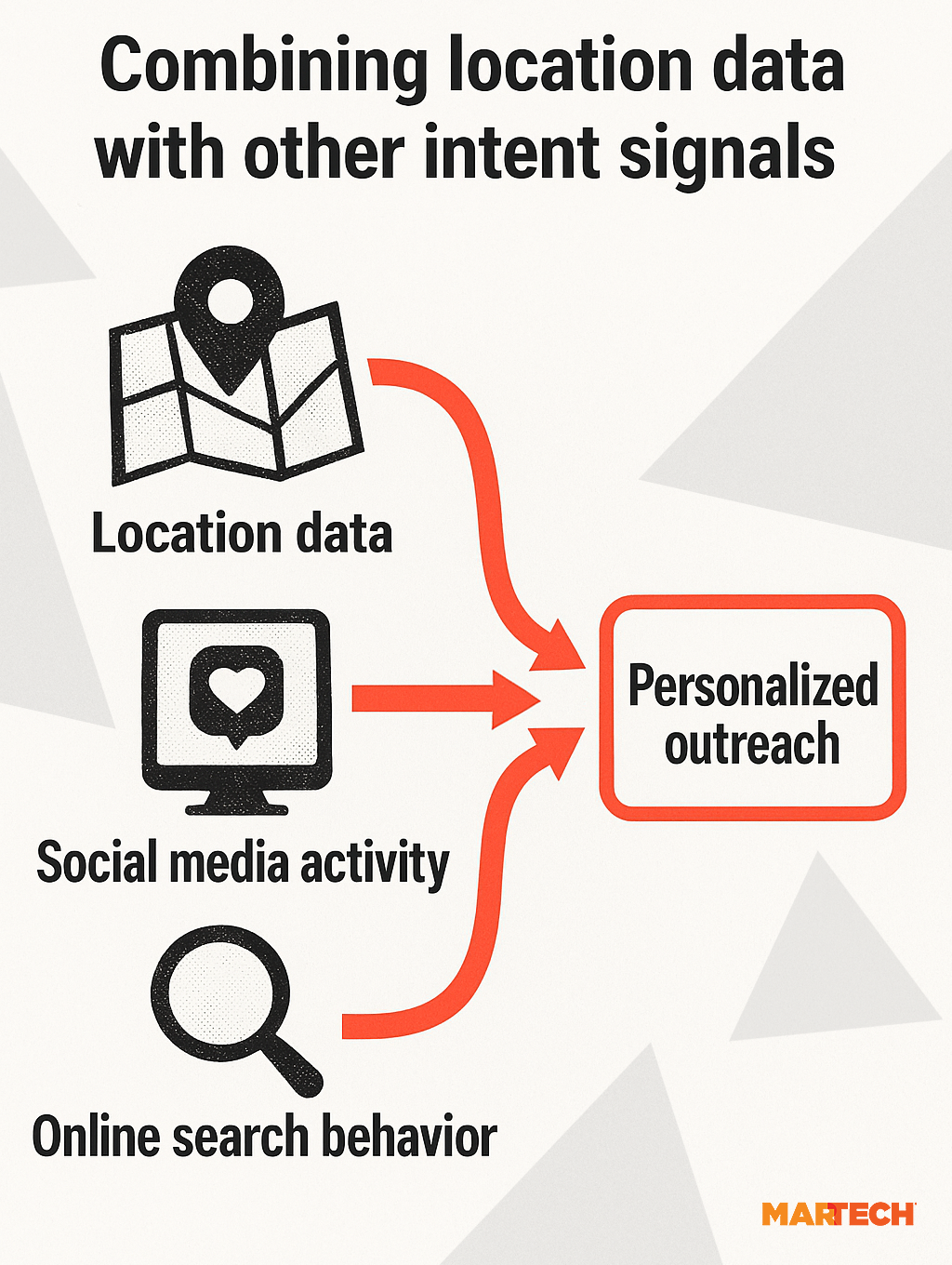
For example, an automotive dealership might track customers who visited competitor lots using location data. The marketing team could filter by people who post about car shopping frustrations on social media. Then, they could reach out with helpful information about the dealership’s stress-free buying process.
Conversational campaigns triggered by geolocation
AI-powered chatbots and voice assistants can create interactive experiences based on where customers are located.
For instance, a customer might text a store’s AI bot while shopping and receive personalized assistance. Then, the customer might receive messages like “Looking for laptops? Here’s where to find them in the electronics section.”
5G and real-time geofencing at scale
5G networks enable instant location-based messaging with virtually no delay. They allow for truly real-time interactions.
This means a customer walking past your store could receive a personalized offer that appears on their phone immediately, rather than several minutes later when they’re already past your location. As this technology continues to advance, it will likely allow for real-time geofencing at scale.
Start small and scale smart with location marketing
Location-based marketing works best when it solves real customer problems and business challenges. Start small, measure carefully, and scale based on proven results rather than technology promises.
Focus on creating genuinely helpful experiences that happen to use location data. By prioritizing good user experience, you can create valuable messaging that delights instead of frustrates customers.
Here’s how to get started:
- Begin with pilot programs. Test small-scale geofencing or beacon implementations. Go beyond engagement rates and measure actual business impact like foot traffic increases and sales attribution.
- Prioritize privacy compliance. Don’t treat privacy as an afterthought. Build transparent opt-in processes and clear value exchanges that respect customer preferences while delivering business results.
- Invest in integration capabilities. Connect location data with your existing customer data platforms, CRM systems, and marketing automation tools for comprehensive campaign orchestration. This will make it easier to run effective campaigns.
Next, check out our webinar discussing how to maximize customer opt-ins. You’ll learn the ultimate consent strategy to scale opt-ins and collect actionable data.
New on MarTech